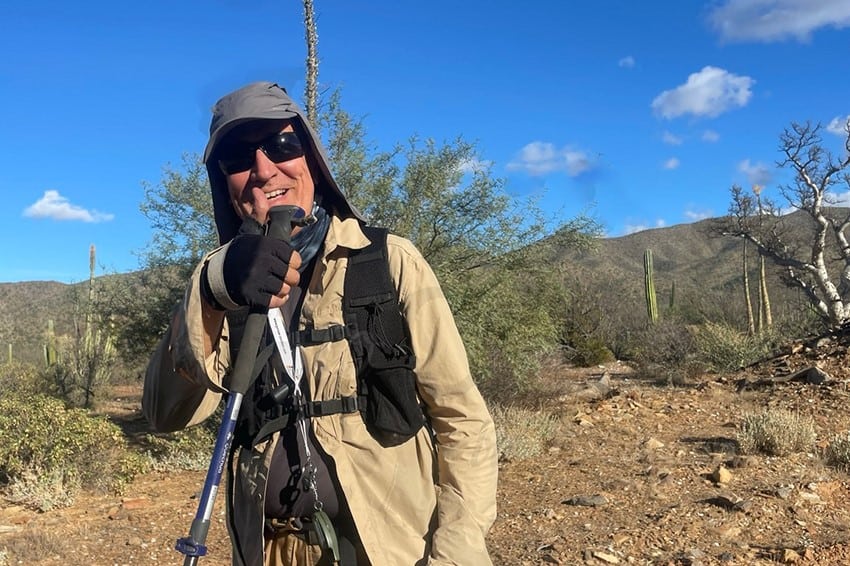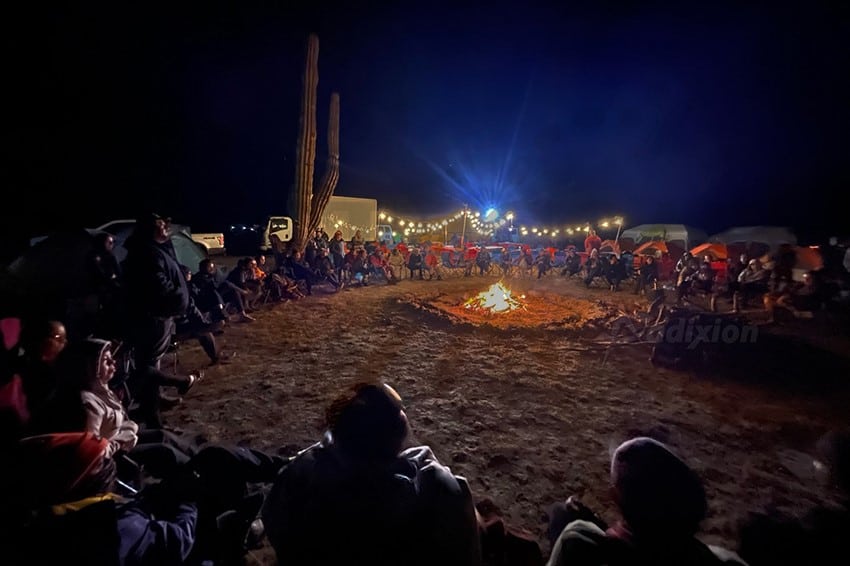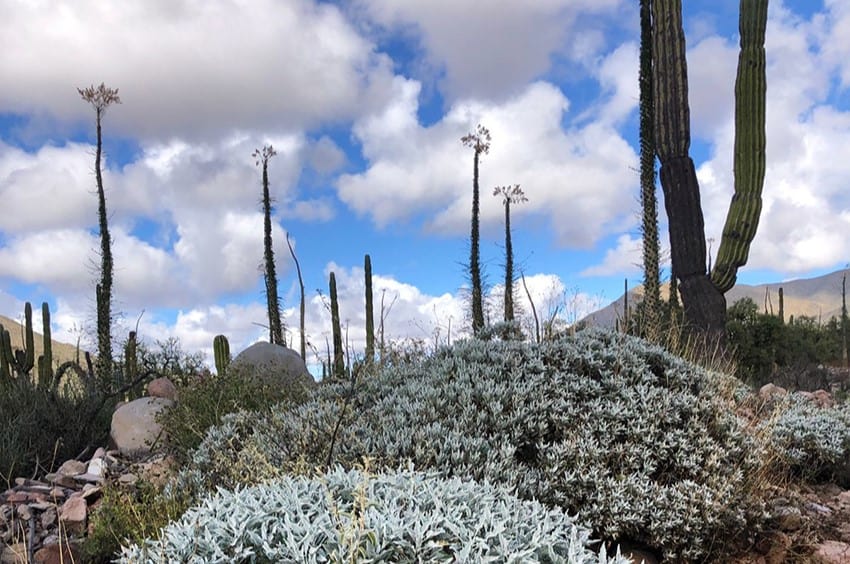Trekking across the width of Baja California

In 1685, Franciscan missionary, explorer, cartographer and astronomer Padre Eusebio Kino led the first non-indigenous expedition across the width of Baja California, through the high walls and treacherous canyons of La Sierra de la Giganta.
Today you can repeat Kino’s feat—but via a much more hiker-friendly route—thanks to an organization called Adixion, which operates out of Mexicali. Their Coast to Coast trail is 111 kilometers long and is perhaps the most popular of very few organized trekking routes to be found in Mexico.
Retired Guadalajara businessman Hector Casas walked this trail last year and claims it was one of the best experiences of his life.
“So what’s so special about trekking in Baja California?” I asked him.
“Baja California has always been one of my favorite places,” Casas replied. “Just for starters, take the Sea of Cortez. Jacques Cousteau called it the World’s Aquarium. Its turquoise waters are filled with thousands of amazing and rare species of sea creatures. But in addition to marine life, I love the desert, the cacti, the dunes. So I decided to give this route a try, to see if I could walk all the way from one coast to the other.
Surrounded by spectacular mountains and a salty lake
“I found out that Adixion Tours organizes the walk every year in November. They only do it in the winter because in the summer the temperature in the peninsula can reach 45 Celsius (113 Fahrenheit). In the winter, however, it’s a pleasant 24 C (75 F), with partly cloudy skies and even a bit of drizzle.”

Participants in the trek typically fly to Tijuana and travel to Mexicali by bus via what Casas describes as a “beautiful route through the Rumorosa Mountains, which are really spectacular on the Mexican side.”
Step two is a four-hour trip by bus and four-wheel-drive which passes through Baja’s celebrated Laguna Salada (Salty Lake) situated ten meters below sea level, finally arriving at the trek’s Kilometer Zero: Altamira Beach on the Pacific Coast.
“Here,” says Casas, “we found our tents already pitched for us and a great dinner to boot. I was surprised to find that one hundred people had signed up to do this trek. The next morning, after a delicious breakfast, we all went to touch the water of the Pacific Ocean and at 7:00 a.m. we started to walk.
50 kilometers of “la pura gloria”
“The trail is well marked. There’s no chance of getting lost, which is important because sometimes you find yourself walking all alone with no one else in sight ahead or behind. This trek was so well organized, I never had to carry anything on my back but water and I really didn’t need it because every five kilometers they have a checkpoint set up, with fruit and drinks, and at certain points there’s even a tent with paramedics ready to take care of possible blisters or whatever. So at each of these spots I would stop, take off my shoes and socks, and enjoy the refreshments. It was la pura gloria, pure glory! That’s how it went the first day and at 6:30 p.m. I arrived at the Mission of San Borja, 50 kilometers from my starting point.”

5-star hotel in the desert
Here the weary trekkers found their tents set up for them, each containing all their personal gear. At San Borja they could take a shower and then enjoy a fine dinner, such as spaghetti, fettucini, or fish fillets. Vegetarians, vegans, or anyone with a special diet could expect a meal designed just for them. “As far as I was concerned,” said Casas, “this was a five-star hotel in the desert.”
“The next morning we were back on the trail at 7:00,” continues Casas. “Everyone was friendly and I would sometimes chat with them or other times I would just appreciate the scenery by myself and enjoy moments of introspection.”
El cirio: the strangest tree on earth
On this second day, the trekkers entered El Valle de los Cirios (The Valley of the Candles) a wildlife protection area famed for what is often considered the strangest tree on earth: the “cirio” or “boojum” tree, a magnificent succulent — said to resemble an upside-down carrot — which can grow to an astonishing height of 26 meters (85 feet).
According to the international organization Wildcoast, Valle de los Cirios is globally unique: “There may be no other place that embodies the wild Pacific coastal landscapes of the Baja California peninsula than Valle de los Cirios… With some luck and a lot of patience, a visitor can catch glimpses of mule deer, kit foxes, bobcats, and stealthy mountain lions that wander among the giant Cardon cactus and fantastical cirios or boojum trees.”

A sky filled with stars
Trekkers who found the going difficult also found an easy solution to their problem. All they had to do is wait for a barredora, (a sweeper). This was a four-wheel-drive vehicle that would pick up those who no longer wanted to walk. “We all understood,” said Casas, “that this was no competition, but rather a personal challenge. No one cared who arrived first.”
Entranced by the bizarre forest of boojum trees, the trekkers arrived at Agua de Higueras, “a little valley in the middle of nowhere, with no one to be seen but us trekkers.” Here the participants enjoyed a sky full of stars along with a spectacular display of meteorites. In this remote spot there was no cell phone service, but the tour organizers used satellite phones to communicate with the outside world.
“I couldn’t resist poking my head out of my tent at 2:00 in the morning, just for another look at that incredible sky,” says Casas.
The next day, a final 30-kilometer walk brought the trekkers to the Bay of Los Angeles on the Sea of Cortez… and a good night’s sleep in a real bed.
“I loved this trek,” said Hector Casas with a wistful look in his eye. “I loved it so much that I’ve signed up to do it again this coming November!”
If you’d like more information on the upcoming 2024 trek, visit the Baja Coast to Coast website.
John Pint has lived near Guadalajara, Jalisco, for more than 30 years and is the author of A Guide to West Mexico’s Guachimontones and Surrounding Area and co-author of Outdoors in Western Mexico. More of his writing can be found on his website.
Source: Mexico News Daily

